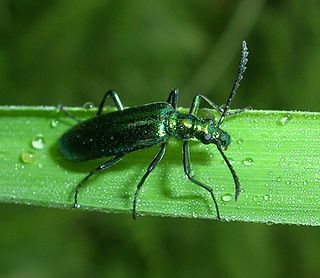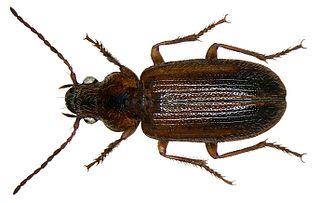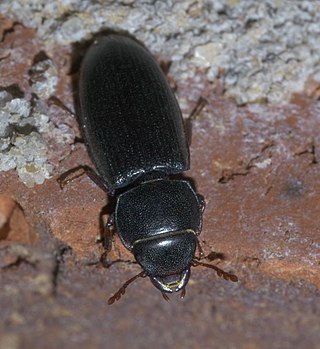
Lampyris is a genus of beetles in the Lampyridae. In most of western Eurasia, they are the predominant members of this family and includes the European common glow-worm, which is the type species. They produce a continuous glow; the larvae and larviform females are among those organisms commonly called "glowworms".

Jules René Bourguignat was a French malacologist, a scientist who studied mollusks. He served as secretary-general of the Société malacologique de France. He traveled widely, visiting, for example, Lake Tanganyika and North Africa. He reportedly defined 112 new genera and around 2540 new species of mollusks.

Asaphidion is a Holarctic genus of ground beetle native to Europe, the Near East, North Africa, and North America.

Prionoceridae is a small family of beetles, in the suborder Polyphaga. They form a group within the cleroid beetles and were formerly treated as a subfamily (Prionocerinae) within the family Melyridae. Very little is known of their life history but most species are pollen feeders as adults and occur in large numbers during spring or the host flowering season. Larvae are predatory or feed on decomposing wood.

Dicheirotrichus is a genus in the beetle family Carabidae. There are more than 50 described species in Dicheirotrichus.

Stenocrepis is a genus of beetles in the family Carabidae, containing the following 31 species:

Typhloreicheia is a genus in the beetle family Carabidae, found mainly in Italy. The species of Typhloreicheia, like most in the subtribe Reicheiina, are generally small, 1-4 mm, and have reduced or absent eyes. They often live below ground and in caves.
Hypotyphlus is a genus of ground beetles in the family Carabidae. There are about 16 described species in Hypotyphlus.
Microtyphlus is a genus in the beetle family Carabidae. There are at least 20 described species in Microtyphlus.
Prioniomus is a genus of beetles in the family Carabidae, containing the following species:
Typhlocharis is a genus of ground beetles in the family Carabidae. There are more than 60 described species in Typhlocharis.

Ocys is a genus of ground beetles in the family Carabidae. There are at least 30 described species in Ocys.

Sinechostictus is a genus of ground beetles in the family Carabidae. There are more than 30 described species in Sinechostictus.
Aphaenops is a genus of beetles in the family Carabidae, containing the following species: All species in the genus are obligate troglobites, and each species is usually endemic to a single cave system; they are unpigmented, and have no functional eyes.

Duvalius is a genus of beetles in the family Carabidae. They are distributed from the Mediterranean area to northwestern China. They typically live in caves and in shallow subterranean spaces. Many species are rare and have very restricted distributions.

Enicopus is a genus of soft-winged flower beetles belonging to the family Melyridae, subfamily Dasytinae. Species in this genus are present in most of Europe and in the eastern Palearctic realm.

Bembidiini is a tribe of ground beetles in the family Carabidae. There are more than 120 genera and 3,100 described species in Bembidiini.

Tenebroides is a genus of bark-gnawing beetles in the family Trogossitidae. There are at least 20 described species in Tenebroides.

Pycnomerus is a genus of ironclad beetles in the family Zopheridae. There are more than 20 described species in Pycnomerus.
Sunius is a genus of rove beetles in the family Staphylinidae. There are more than 60 described species in Sunius.













